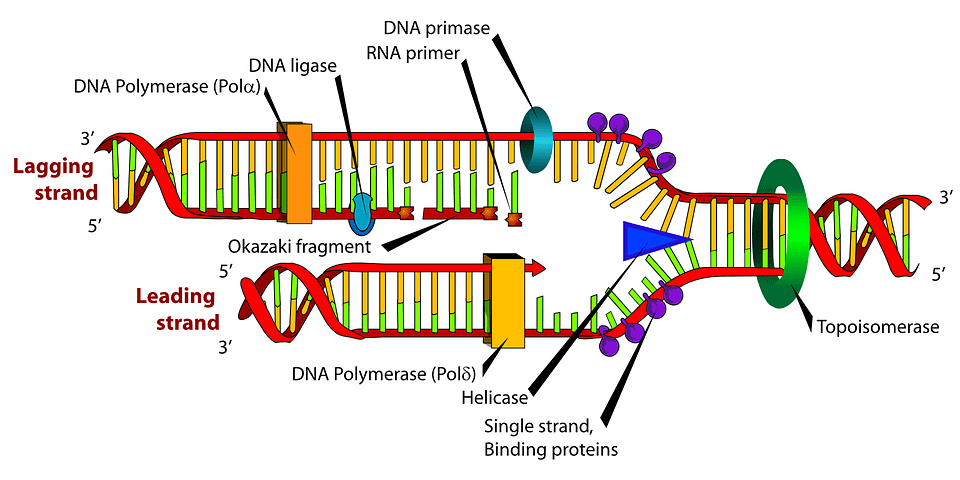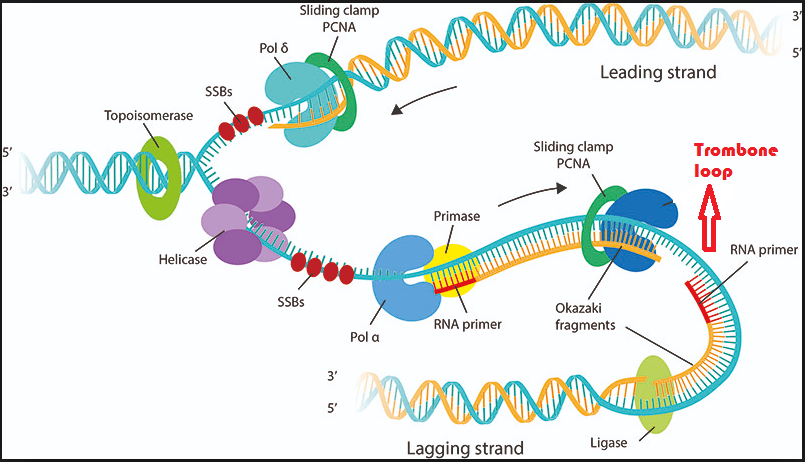Models of DNA replication, notes with Definition & diagram
DNA replication simple definition
“DNA replication is the process in which the parent DNA molecule produces its identical copy during cell division” This is a necessary step because each newly formed cell has to receive a copy of DNA material so that parental characteristics may be transferred to successive generations. Summary of DNA replication notes is right below
Proposed models of DNA replication
There are three possible schemes of DNA replication.

1- Semiconservative replication
“Replication scheme in which it is proposed that both DNA strands unwind and each individual strand acts as a template for the synthesis another complementary strand is called semiconservative replication. This is the most accepted scheme of DNA replication”
According to this scheme integrity of each strand is preserved but the hydrogen bonds between strands break allowing the two parent strands to be separate and take part in the formation to their respective complementary strands. When replication is over two daughter DNA molecules are formed which are identical to each other and are a photocopy of the parent DNA molecule. One strand in each daughter DNA molecule is intact template (parental) and other is an intact newly replicated DNA strand.
2- Conservative replication
It is an alternative method of replication. According to this model original double helix of parental DNA molecule is conserved. Two strands of a double helix of DNA remains joined to each other and individual chains remain intact. Hydrogen bonds between DNA strands remain stable and original parental double helix acts as a template for the formation of entirely new daughter DNA molecule in which all nucleotides subunits are entirely new.
3- Dispersive Replication
In this scheme of replication two strands of parental DNA molecule totally disintegrate. Not only hydrogen bonds between two strands break and separate two strands but phosphodiester linkage between nucleotides of each strand break and individual nucleotides disperse in the medium. From parental nucleotides and new precursors, two daughter DNA molecules are formed. Daughter molecule consists of the part of template parental strand and part of newly synthesized DNA.
DNA REPLICATION PROCEDURE
DNA replication is semi-conservative. Before Watson and Crick model it was believed that DNA molecule undergoes self-duplication or replication, but the exact procedure was not known. Watson and Crick’s model provided a base for the replication procedure. Watson and Crick propose a possible mechanism of DNA replication. Their suggestion was based on the principle of complementarity.

Semiconservative replication steps
- As the first step of replication hydrogen bonds between nitrogen basses of two complementary strand of DNA molecule disintegrate and two strands become separated from each other. Enzyme DNA Helicase unwinds DNA strands and dissolves hydrogen bonds.
- Each strand maintains its integrity and does not break down further.
- Each Strand acts as a template (a guide or blueprint) or pattern for the formation of a new strand, one which is complementary to it.
- The complementary strands for each parental template strand are synthesized from new precursor molecules within the medium.
- As the sugar-phosphate backbone of a new strand is assembled, nitrogen basses in original parental strand attract the complementary one. e.g. T in the original strand will attract A nitrogen base to be attached with newly assembled strand and hydrogen bonds between these two are formed.
- This complementary attraction by bases in original parental strand results in the formation of two new strands, each complementary to the original old ones.
- This whole process of replication is carried out by a DNA polymerase enzyme.
Frequently asked questions about DNA replication
1- What causes DNA to replicate? or How did DNA learn to replicate itself?
DNA is not living itself, nor it has conscious control over its multiplication within the cell. It can be replicated in a lab but within cell, it must have to receive messages from the cell in the form of various proteins which stimulates it to replicate itself. Replication of DNA occurs during the S phase of interphase and it further pushes the cell towards cell division (Mitotic phase). Dozens enzymes and cofactors, acting precisely in an accurate amount carry on very specific roles for initiating replication process.
2- How does DNA replication work?
“DNA replication is the process of production of two identical copies of DNA from one parental DNA molecule”
DNA is composed of a double helix of two complementary strands. These strands are separated, during replication. Every single strand of the original parent DNA molecule serves as a template for the production of its complementary strand, a process called semiconservative replication.
3- What are the enzymes involved in DNA replication?
DNA replication is carried out by several enzymes listed below along with their role.
- DNA POLYMERASE: This enzyme carried out the process of DNA replication in all organisms. It catalyzes the DNA replication in 5′ to 3′ direction.
- TOPOISOMERASE: This enzyme carries out overwinding or underwinding of DNA.
- HELICASE: These are used to separate strands of a DNA Double helix by using the energy from ATP hydrolysis.
- DNA GYRASE: It is a specific type of topoisomerase which relieves the strain of unwinding by DNA helicase.
- DNA LIGASE It re-anneals the semi-conservative strands and joins OKAZAKI FRAGMENT of the lagging DNA strand.
- PRIMASE: It catalyzes the synthesis of a short RNA segment called a “primer” complementary to an ssDNA template.
4- What is the trombone model of DNA replication?

During this type of DNA replication, the double-stranded DNA opens into a ‘leading’ and ‘lagging’ strand. The leading strand is complemented by the usual base pairing. However, in the lagging strand, RNA primers are attached to initiate joining pf complementary DNA deoxyribonucleotides in the 3′-5’direction hence form Okazaki fragments. Later the RNA primers are replaced by DNA.
So, DNA replication occurs within a fork-like structure in which the lagging strand loops around in a proposed “trombone model” to orient the replication enzymes for repeated synthesis and joining. It is considered that this mechanism helps to maintain the integrity of DNA during the replication cycles.
5- What is the theta model of DNA replication?

The theta mode is adopted by the prokaryotes to replicate their DNA. Their circular DNA has only a single point of origin for replication, unlike the eukaryotic DNA which has multiple origin points to make the process faster.
The action of helicase enzyme literally unzips the strands of the parental DNA, by breaking the bonds. Then DNA polymerase enzyme comes into action and starts replication in the 5′ to 3′ direction. Once the replication is done, ligase enzyme joins the loose ends together and so, two daughter DNA strands are formed.
As during the action of the helicase enzyme, the circular DNA forms the Greek symbol ‘θ’ like structure, this model is named theta model of DNA replication.
6- What are the 4 steps of replication?
-
- 1: Replication Fork Formation
- 2: Primer Binding
- 3: Elongation
- 4: Termination
You May Also Interested:
